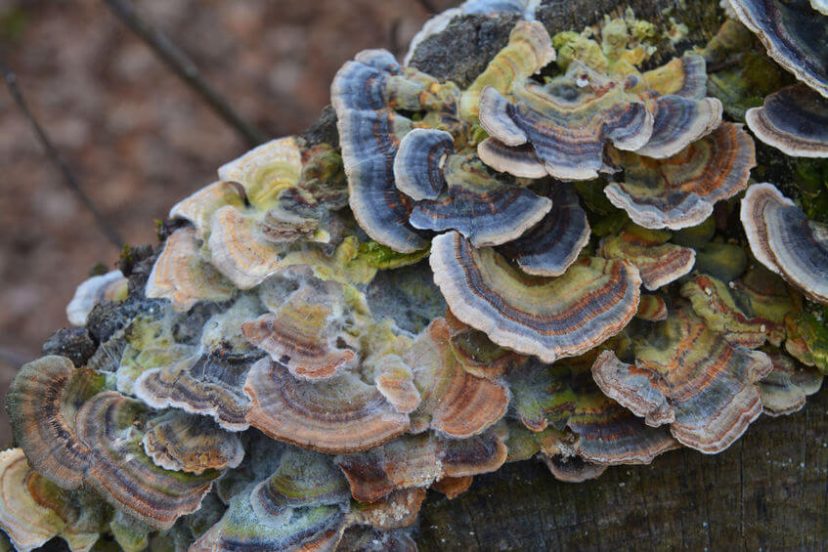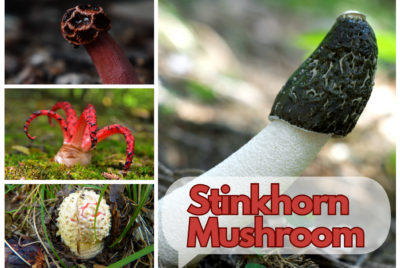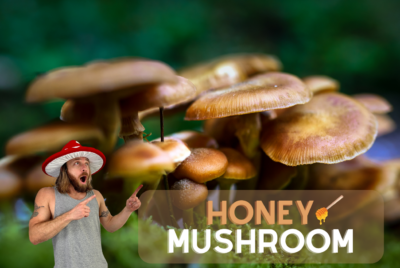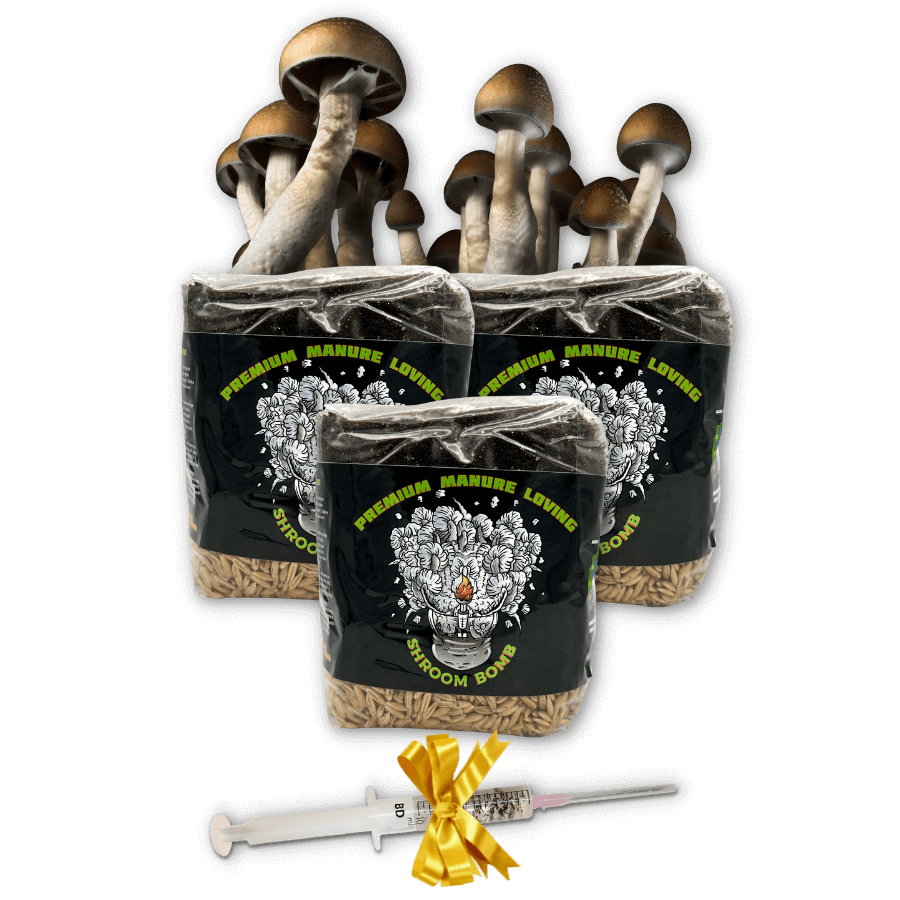Mushroom enthusiasts and foragers are often captivated by the diverse and mysterious world of fungi. Among…
Turkey Tail Mushroom Identification & Look Alikes, Benefits & Side Effects

Turkey tail (Trametes versicolor) mushroom identification will come in useful because it has many look-alikes that look very similar. There are 50 species of the Trametes family.
The Turkey tail mushroom and it’s 2 look-alikes are the most common types of mushroom you will see when walking in the woods, foraging or hiking.
It’s 2 closest and most commonly found look-alikes are the violet toothed polypore (Trichaptum biforme) and the false turkey tail (Stereum ostrea).
Where Do Turkey Tail Mushrooms Grow?
This mushroom isn’t really that rare compared to, say, Morels. There season lasts for a whopping 8 months of the year while most mushrooms only grow for around 2 months. It’s actually available all year round but will start to become dryish until he new season start.
A lot of beginners can see them on their first foraging trip. However, the price tag is due mostly to the fact that they are proven to have many medicinal health benefits.
So let’s talk about how to identify Turkey tail mushrooms in the wild. We’ll also talk about how they are used and why they are considered a medicinal mushroom.
6 Turkey Tail Mushroom Identification Tips
While Turkey Tails are quite common and they have a few look-alikes, it’s actually easy to identify them. While it may take time to master, a few foraging trips should be more than enough for you to master the 6-step Turkey tail mushroom identification process.
1) Does it have pores?
One of the distinguishing characteristics of turkey tails are the pores in its underside. Being a polypore, it does not have gills unlike other mushrooms.
Another mushroom, called the False Turkey Tail looks like real mushrooms from the top but once you flip it over you can see the difference as the false turkey tail has a smooth underside.
While not toxic, the false turkey tail is not palatable either. While some people claim they have medicinal purposes, there are no studies showing their effects.
2) How big are the pores?

Now that you have seen the pores, check how big they are. If you really need to squint to see them then you probably have the real thing. They should have 1 to 3 pores per millimeter.
Some Trametes mushrooms look like turkey tails but have slightly larger pores. One way of making sure is to get a ballpoint pen and putting it up next to the pores. If you see anywhere from 2-3 pores in the space occupied by the tip then it is a turkey tail.
3) Is it fuzzy?
Bear with me on this one. When checking if a mushroom is indeed a turkey tail, you need to check if it is fuzzy or not. No, we are not looking for “hairy”.
Instead, use your fingers to see if you can detect a velvety feel from the mushroom. If it’s not fuzzy or velvety then you might have a different mushroom in your hands.
4) Is it white or grey?
One look alike of the turkey tail is called the hairy bracket fungus. The difference is in the coloration.
While turkey tails have striped colored rings, these fungi are grey or white. A closer look also reveals they are fuzzier (have longer “hair” than the turkey tail).
While this mushroom is very colorful and beautiful on the top, when you flip the mushroom on it’s underside it should be white when its fresh. As it ages though, it could turn a slight yellowish to brown.
5) Can you detect the concentric color zones?
A turkey tail has distinct color zones. You can clearly see the division between two different colors in its cap.
For some of its look-alike, the zones aren’t very clear and sometimes they are just textural in nature. For example, a look-alike called the Trametes Pubescens may look like they have color zones but if you examine it carefully you will see that these are just textural zones.
6) Is it flexible and thin?
A true turkey tail mushroom is thin and flexible – even after it has been dried. It flesh is about 1 to 3 mm thick. While drying removes some of its flexibility, it will never turn hard and rigid.
If you have a hard and rigid mushroom then you have another look-alike called the Trametes Ochracea.
So to recap, here are the qualities you need to look for to ensure you have a legit turkey tail mushroom:
1) Should have pores on the underside
2) Pores should be very small and barely visible.
3) Cap should be fuzzy with hairs that are barely visible
4) You should be able to distinguish the concentric color zones
5) Color may vary but it should be brown, reddish brown, grey, or white with concentric color zones.
6) Cap should be thin and flexible
2 Top Turkey Tail Mushroom Look Alikes
Lets take a look at the 2 most common mushrooms similar to turkey tail that you are sure to find while you are out looking for the True Turkey tail mushroom:
1) False Turkey Tail Mushrooms Identification
The False Turkey tail is not a polypore like the True Turkey tail so it does not have pores on the underside. It is a shelf like bracket looking mushroom similar to the True Turkey tail.
This one is a crust fungus. When you fist see this mushroom you may think it looks like a paint stain on the mood when it is actually a mushroom.
It is kinda velvety like the True Turkey tail and does have the multi-color concentric zones on the cap surface. They kinda curl up and make a type of funnel shape while the True Turkey tails are flat.
They are about the same size as the True Turkey tail in they are both around 2 inches wide.
The biggest difference between the False Turkey tail and the True Turkey tail is the underside. The underside of the False turkey tail is reddish, tannish or brownish and completely flat while the True turkey tail is whitish with pores.
2) Violet Toothed Polypore
This mushroom looks similar to the Turkey tail from the top side in that it has the multi-colored concentric zones but the color is more subdued in that they will be mostly whites, greys and a little brown. The Turkey tail will have much more prevalent colors like reds, browns, greys, blues and purples.
They are typically a little less than 2 inches wide across while the Turkey tail are 2 to 4 inches wide.
The biggest difference is on the underside. While it is a polypore like the Turkey tail it’s pore surface are more teeth like that spread apart. The underside will also have a violet colored hue while the Turkey tail will be mostly white.
What are Turkey Tail Mushrooms?
Turkey tail mushrooms is a common name for three different mushrooms: Trametes versicolor, Coriolus versicolor, and Polyporus versicolor.
In China, they are called Yun Zhi or cloud fungus for their appearance. The Japanese call them Kawaratake or “mushroom by the riverbank” as they are usually found in dead or decaying logs along the riverbank.
Turkey tails are sought after in the US and other countries for its medicinal use.
Turkey tails are considered one of the most common fungi in Canada and all throughout the United States. If you can find a dead hardwood then you can more or less find a turkey tail on it.
The fruiting season of turkey tails start around May throughout December. That’s a whopping 8 months!
Why are Turkey Tail Mushrooms So Popular?
As what I have mentioned above, turkey tails fetch a higher price compared to other mushrooms. However, I’ve also said that they are one of the most common mushrooms in Canada and the US so why the high price?
Simple. Because many people hail Turkey tails as magic medicine.
In places such as China where they really value herbal medicine, turkey tails are sold in the markets. However, in the US, only a few suppliers know how to prepare Turkey tail mushroom. So there is some demand for them although you can actually just forage for them especially if you are a beginner.
Turkey tails can’t be eaten as they are quite rough and tough. Most people who use them for medicinal purposes use fresh turkey tails as tea.
Drying the Turkey tail mushroom is the recommended method of use. Dried turkey tail mushrooms can be used to brew tea or added to other teas. Some people even add dried turkey tails to soups and other meals.
Top 4 Turkey Tail Mushroom Benefits for Health
The Turkey tail is a premiere mushroom when it comes to it’s medicinal health benefits and it’s ability to boost the immune system. It has been used for centuries in Asian medicine and is one of the most researched mushrooms for it’s health benefits.
The easiest way to benefit from the benefits of the Turkey tail mushroom is to buy it in supplement form but can also be hunted, grown or bought dried or fresh as well.
It’s health benefits are not only for humans for the land as well. Some of it’s medicinal properties include it being a detoxifier for the land by removing polycyclic, aromatic hydrocarbons, Polychlorinated biphenyls (PCBs) and synthetic dyes.
It health benefits for humans are mainly through its beta glucans which make up the cell walls of fungi. They are essentially polymers of glucose.
Beta glucans work in our bodies as immune system regulators. They stimulate processes in the body, such as:
1) Phagocytosis – How your immune system kills viruses and bacteria.
2) Natural killer cell activity – Kills cancer cells.
3) Macrophage activity – Types of while blood cells that destroy cellular debris, cancer cells and foreign substances.
4) Suppress Pro Inflammatory Cytokines release – Stop cells that promote inflammation in the body.
It also has been proven to have many anti-cancerous properties, such as:
1) Lung Cancer
2) Gastric Cancer
3) Colorectal Cancer
One study published in ISRN Oncology show that when women with breast cancer were given 6 grams of Turkey tail it led to faster immune recovery after they received radio therapy.
The the Journal of Clinical Oncology published a study 2002 that proved in over 30 clinic trials, when cancer patients were given Turkey tail extract they showed significant improvement in survival rate and general health.
Conclusion
Now that you know how to distinguish turkey tail mushrooms from its many look-alikes, tell us your story about your foraging adventures. Do you have any other tips on where, when, and how to look for turkey tail mushrooms?
With there being so many types of Turkey tail mushroom look-alikes it is important to understand the Turkey tail mushroom identification process so that you can distinguish an actual Turkey tail from it’s posers. It is the most common mushroom to find all year round and it’s many medicinal health benefits make it well worth going for a short hike to forage.
If you find that you don’t want to go out and look for them then you can always order them dried out or in supplement form and still receive the same health benefits.
Like This Article? Pin It on Pinterest!











Brilliant – just picked one and am going to check!
Can Turkey Tail get “old”?
It’s on my firewood and I don’t know if it’s too old or too dry to be useful.
Thanks!
DJ
Normally if they get old they just get dried out. That is fine because once dried they can be used for years. As long as you don’t see them rotting or anything you should be fine.
Hi
I wonder if you would mind taking a look at the mushroom/fungus I have found on a rotting willow trunk in my garden, I believe it to be turkey tail but I’m not that confident!
Many thanks
Louise
That definitely look like turkey tail but need a picture of the underside to confirm.
I have a mushroom I am relatively sure is not the turkey tail but would appreciate some help identifying it. They were on a live tree and seem to be dry.
I dont think this is the turkey tale but would appreciate help in identifying it. It seems to be dried out and was growing on a standing tree.
I have found this article very useful! Haven’t been brave enough to pick mushrooms before,but this article has given me that push!????
Found these in Houston TX on a felled tree.
These do not look like the usual Turkey Tail mushroom. These are probably aged ones that dry out a bit. Still, this does not suggest that they are edible.
[…] the name suggests, turkey tail mushrooms resemble the tails of wild turkeys. They’re brown or black in color and have a chewy texture. […]
[…] Turkeytail- The Wildlife Trusts Turkey Tail- Wild Food UK Complete Guide to Turkey Tail Mushroom (Trametes versicolor)- FreshCap Identify Turkey Tails Mushroom- Totally Wild UK Turkey Tail Mushroom Products- Indigo Herbs Do turkey tail mushrooms benefit health?- Medical News Today Turkey Tail Mushroom Identification & Look Alikes, Benefits & Side Effects- Curative Mushroo… […]